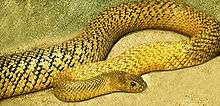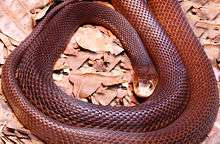Taipan
Taipans are snakes of the genus Oxyuranus in the elapid family. They are large, fast-moving, highly venomous, and endemic to Australasia. There are currently three recognised species, one of which, the coastal taipan, has two subspecies. Taipans are considered some of the deadliest known snakes.
| Taipan | |
|---|---|
 | |
| Inland taipan (Oxyuranus microlepidotus) | |
| Scientific classification | |
| Kingdom: | Animalia |
| Phylum: | Chordata |
| Class: | Reptilia |
| Order: | Squamata |
| Suborder: | Serpentes |
| Family: | Elapidae |
| Subfamily: | Hydrophiinae |
| Genus: | Oxyuranus Kinghorn, 1923[1] |
| Species | |
|
See text | |
Taxonomy
The common name, taipan, was coined by anthropologist Donald Thomson after the word used by the Wik-Mungkan Aboriginal people of central Cape York Peninsula, Queensland, Australia.[2] The genus name is from Greek oxys (sharp, needle-like) and ouranos (an arch, specifically the arch of the heavens), and refers to the needle-like anterior process on the arch of the palate, which Kinghorn noted separated the genus from all other elapids. The oft-quoted meaning 'sharp-tailed' is both etymologically and morphologically incorrect.[3]
The three known species are: the coastal taipan (Oxyuranus scutellatus), the inland taipan (Oxyuranus microlepidotus), and a recently discovered third species, the Central Ranges taipan (Oxyuranus temporalis).[4] The coastal taipan has two subspecies: the coastal taipan (O. s. scutellatus), found along the northeastern coast of Queensland, and the Papuan taipan (O. s. canni), found on the southern coast of Papua New Guinea.
A 2016 genetic analysis showed that the speckled brown snake was an early offshoot of a lineage giving rise to the taipans, with the central ranges taipan being an offshoot of the common ancestor of the inland and coastal taipans.[5]
Diet
Their diets consist primarily of small mammals, especially rats and bandicoots.
Venom

Species of this genus possess highly neurotoxic venom with some other toxic constituents that have multiple effects on victims. The venom is known to paralyse the victim's nervous system and clot the blood, which then blocks blood vessels and uses up clotting factors. Members of this genus are considered to be among the most venomous land snakes based on their murine LD50, an indicator of the toxicity on mice. The inland taipan is considered to be the most venomous land snake and the coastal taipan, which is arguably the largest Australian venomous snake, is the third-most venomous land snake.[7] The central ranges taipan has been less researched than other species of this genus, so the exact toxicity of its venom is still not clear, but it may be even more venomous than the other taipan species.[8] Apart from venom toxicity, quantities of venom delivered should also be taken into account for the danger posed. The coastal taipan is capable of injecting a large quantity of venom due to its large size.[9]
In 1950, Kevin Budden, an amateur herpetologist, was one of the first people to capture a taipan alive, although he was bitten in the process and died the next day.[10] The snake, which ended up dying a few weeks later, was milked by Melbourne zoologist David Fleay and its venom used to develop an antivenom, which became available in 1955.[11][12]
Two antivenoms are available: CSL Polyvalent antivenom and CSL Taipan antivenom, both from CSL Limited in Australia.[13]
In his book Venom, which explores the development of a taipan antivenom in Australia in the 1940s and 1950s, author Brendan James Murray argues that only one person is known to have survived an Oxyuranus bite without antivenom: George Rosendale, a Guugu Yimithirr person bitten at Hope Vale in 1949. Murray writes that Rosendale's condition was so severe that nurses later showed him extracted samples of his own blood that were completely black in colour.
Temperament also varies from species to species. The inland taipan is generally shy while the coastal taipan can be quite aggressive when cornered and will actively defend itself.[9]
References
- ITIS (Integrated Taxonomic Information System). www.itis.gov.
- Sutton, Peter (1995). Wik Ngathan Dictionary.
- Meagher, David (2012). An etymology of the scientific names of Victorian snakes. The Victorian Naturalist 129(1): 54-60.
- Doughty, P.; Maryan, B.; Donnellan, S. & Hutchinson, M. (2007). "A New Species of Taipan (Elapidae: Oxyuranus) from Central Australia" (PDF). Zootaxa. 1422: 45–58.
- Figueroa, A.; McKelvy, A. D.; Grismer, L. L.; Bell, C. D.; Lailvaux, S. P. (2016). "A species-level phylogeny of extant snakes with description of a new colubrid subfamily and genus". PLoS ONE. 11 (9): e0161070. doi:10.1371/journal.pone.0161070. PMC 5014348. PMID 27603205.
- The Reptile Database. www.reptile-database.org.
- Thomas, Séan & Griessel, Eugene (December 1999). "LD50". seanthomas.net.
- "One of the Most Venomous Snakes in the World 'Oxyuranus temporalis'". International Institute for Species Exploration. Archived from the original on 21 August 2011. Retrieved 21 January 2018.
- "IMMEDIATE FIRST AID for bites by Australian Taipan or Common Taipan". Archived from the original on 2012-04-02.
- "80-Year-Old Vintage Snake Venom Can Still Kill". January 2014. Retrieved 16 January 2014.
- "Taipan "belonga devil"". News. Adelaide, South Australia. 1 August 1950. p. 11. Retrieved 16 January 2014.
- Williams, David (January 2004). "The Death of Kevin Budden". Retrieved 16 January 2014.
- "WHO Blood Products and related Biologicals Animal sera Antivenons frames page". apps.who.int. World Health Organization.
Further reading
- Kinghorn, J.R. 1923. A New Genus of Elapine Snake from Northern Australia. Records of the Australian Museum 14 (1): 42–45 + Plate VII.
("Oxyuranus, gen. nov.", p. 42.) - Murray, Brendan James, 2017, 'Venom: The Heroic Search for Australia's Deadliest Snake,' Echo Publishing, Australia.
External links
| Wikispecies has information related to Oxyuranus |
| Wikimedia Commons has media related to Oxyuranus. |
| Look up taipan in Wiktionary, the free dictionary. |
- Barnett, Brian. "Keeping and Breeding the Coastal Taipan (Oxyuranus scutellatus)." Journal of the Victorian Herpetological Society, 10 (2/3), 1999 (pages 38–45).
- "Coastal Taipan," the Australian Reptile Online Database, www.arod.com.au
- "Inland Taipan," the Australian Reptile Online Database, www.arod.com.au